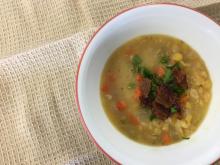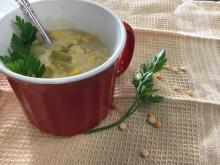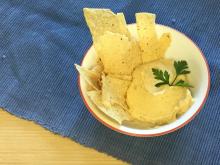
Did you know that Illinois Extension works with local food pantries through our Illinois Nutrition Education Program (INEP)? This includes nutrition education with pantry clients and assistance to pantry coordinators with work called PSE (policy, systems, and environmental change).
I share this because I developed the recipes in this blog at the request of a colleague who was working with a pantry that was getting bags and bags of dried beans, including split peas. At the time, I had never cooked with dry beans, peas, or lentils. (At the time, it was canned beans all the way!) But as is often the case in Extension, we learn through doing and I learned about split peas by making recipes.
Split peas – both green and yellow – are in the pulse family. Split peas are mature, dry peas that have been split in half. A quarter cup of dry peas contains around 180 calories, 30g carbohydrates, 11g fiber, and 11g protein, and are a source of vitamins and minerals, including folate, vitamin K, iron, and zinc. They do not contain significant amounts of fat or sodium. Nutritional content is similar for other members of the pulse family.
- Buy: Unlike other pulses that you might find ready-to-eat out of a can, split peas are usually sold dry. Look for split peas that are a deep color – either yellow or green. Avoid peas that appear faded in color or wrinkled, which may mean the peas are old.
- Price: Dry pulses are inexpensive, though the exact price will vary by your local stores. Near me, most 1-pound (16 ounce) bags cost less than $2.00.
- Store: Keep dry peas at room temperature in a cool, dark area. If the peas came in a bag, move them to an airtight container for long-term storage. Peas will keep at peak quality for around a year.
- Prepare:
- Sorted and rinse. Many recipes using dry pulses will have instructions to “sort and rinse.” To sort them, look through the dry peas for rocks, broken peas, and pulses that aren't split peas and remove them. To rinse, add peas to a colander and rinse under cool water. This removes debris left behind from the soil where they grew and from being at the packing plant.
- No soak. Like lentils and black-eyed peas, split peas do not need to be soaked (though you can soak them) before cooking.
- Eat: Split Pea Soup might be the best-known use of split peas. In this post, we also have a soup, plus a chowder and a dip. Try split peas in curries or even added to salads for extra protein and fiber.
Yellow Split Pea Soup | Print Recipe
Serves 6
Yellow Split Pea and Corn Chowder | Print Recipe
Serves 6
Yellow Split Pea Hummus | Print Recipe
Serves 8
Resources:
- Split Peas, Smart Food Colorado, Colorado State University Extension, 2020.
- What are Pulses?, Global Pulse Confederation, N/D.
- Split Pea Basics, FoodHero, Oregon State University, 2018.
- Split Peas: Are they Peas or Lentils?, University of Illinois Extension.2019.
- Storing Dry Beans, Preserve the Harvest, Utah State University Extension, N/D.
- Pulse Crops, North Dakota State University Extension, N/D.
- Split Peas With Tempered Spices Inspire an Exotic Dish, Prairie Fare, North Dakota State University Extension, 2014.
- Pulses: The Perfect Food, Healthy to Eat, Healthy to Grow; Peas-Lentils-Chickpeas, North Dakota State University Extension, 2017.
- FoodData Central, United States Department of Agriculture.
Post originally published in 2020; content updated in 2022.
Healthy Eats and Repeat
How much difference is there between canned and frozen foods? How should you cook venison? When is the best time to buy avocados? Get answers to these questions as well as other tips, tutorials and recipes for common kitchen foods and items with University of Illinois Extension Nutrition & Wellness Educator Caitlin Mellendorf. Build your best life. Trust Extension to help.
Caitlin Mellendorf is an Illinois Extension Nutrition and Wellness Educator serving DeWitt, Macon and Piatt Counties in Central Illinois. She is a Registered Dietitian and her work focuses on helping community members gain the knowledge, skills and tools to live healthier, more nutritious lifestyles. This includes providing programs and answering questions about heart health, diabetes, food safety, food preservation, grocery shopping and cooking. You can reach Caitlin by email at chuth2@illinois.edu or call 217.877.6042.


